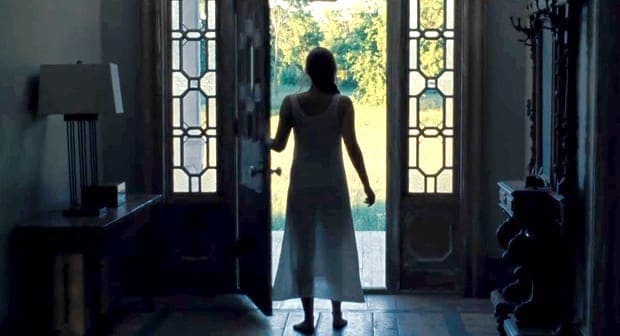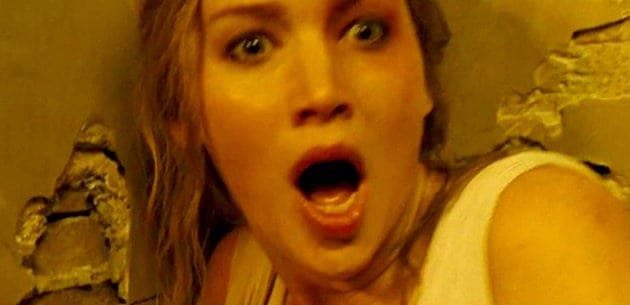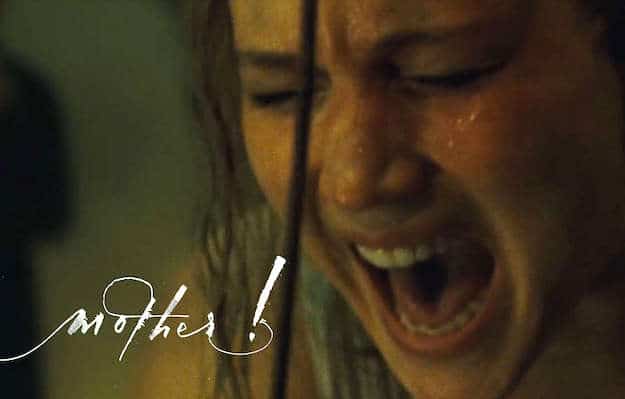Darren “Black Swan” Aronofsky’s latest metaphysical conceit, Mother!, may be many things, but a serious example of cinematic storytelling is not one of them.
A showcase for the bovine beauty and monochromatic facial expressions of his current girlfriend (and star) Jennifer Lawrence, yes. A comprehensible film, no.
It seems that Aronofsky has delusions of mythic grandeur and has used Lawrence’s open-mouthed sense of wonder to convey some of it. Caveat! Lawrence is on-screen 95% of the time. In big close-ups. A lot. But before you think I am simply going to slam this exercise in self-indulgence, stick around. There are a few cinematic thrills in Mother! worth noting.
 Assuming that you have either seen this, or don’t plan to stream/rent later on, I will reveal the way the film’s set-up.
Assuming that you have either seen this, or don’t plan to stream/rent later on, I will reveal the way the film’s set-up.
We begin with a nameless couple—he’s a celebrated poet with major writer’s block (Javier Bardem), she’s a much younger, perfect wife restoring his enormous country mansion that once burned down and now needs work. He prowls around the house, slamming doors and ignoring the beautiful wife. She applies paint samples to the wall and drifts around in nightgowns.
 A knock at the door brings two strangers into their lives (sounds like a modernist theater piece)—a chain-smoking physician with a fatal disease (Ed Harris) and his sultry, hard-drinking wife (Michelle Pfeiffer). These two inject humor and horror in equal proportions into the dull lives of our Couple. Ack! Things begin going wrong, very wrong. The couple’s sons show up, have a violent fight, and one is killed by the other. (I think you can see where this is going.).
A knock at the door brings two strangers into their lives (sounds like a modernist theater piece)—a chain-smoking physician with a fatal disease (Ed Harris) and his sultry, hard-drinking wife (Michelle Pfeiffer). These two inject humor and horror in equal proportions into the dull lives of our Couple. Ack! Things begin going wrong, very wrong. The couple’s sons show up, have a violent fight, and one is killed by the other. (I think you can see where this is going.).
Thanks to an unexpected sexual interlude, the Lawrence character finds herself instantly pregnant, and voila! the great poet can write again. Aronofsky guns it into high gear at this point and leaves all traces of real-world credibility behind. However, the film becomes irresistible, like a major environmental disaster or a six-car pileup.
 Fans of the Poet start showing up — immediately! Somehow they have heard of his new poem. They need to bask in his genius. And he, like any artist worth his ego, needs to be adored. The Wife, now heavily pregnant, is pretty much shoved aside as his followers grow in numbers. Soon they fill the house, all wanting an autograph, and then much more. (More sardonic comedy than serious “message” if you can stomach the horrifying images.)
Fans of the Poet start showing up — immediately! Somehow they have heard of his new poem. They need to bask in his genius. And he, like any artist worth his ego, needs to be adored. The Wife, now heavily pregnant, is pretty much shoved aside as his followers grow in numbers. Soon they fill the house, all wanting an autograph, and then much more. (More sardonic comedy than serious “message” if you can stomach the horrifying images.)
Before I realized how he had done it —chiaro scuro camerawork that Caravaggio would have envied, plus relentless pacing—Aronofsky fast forwards the adoration of the crowd into a stampede for relics of the great man. The wife is literally thrown aside, as the interlopers take over. I was spellbound watching this privileged world unravel, growing from a crowd, to a mob, to an armed camp, to out and out warfare, to a blazing, explosive finale.
And then, out of death, comes the kernel of life again—in the form of artistic inspiration, and the film rewinds itself to the very first frame we saw at the beginning.
Whoa! Let’s review: Is the film a grandiose eco-fable? We’ve got every possible Judeo-Christian metaphor known. God and Nature, Adam and Eve (not a nice two-some), their sons Cain and Abel, the adoring worshippers who turn their Poet/God into a cult figure and begin religious ceremonies (in the kitchen, bathrooms, hallways, you name it) that resemble the Catholic mass and finally human sacrifice. (There are plenty of grotesque images to go around.) Eden is destroyed by—you’ve already guessed it—humanity!
 So it’s an environmental cautionary tale! Okay, another take might be, that Aronofsky is sending up the whole idea of artistic genius, noting that Art is simply a huge case of narcissism, and the cult of the Artist is ultimately a destructive hobby. (This is NOT a new theory, btw.)
So it’s an environmental cautionary tale! Okay, another take might be, that Aronofsky is sending up the whole idea of artistic genius, noting that Art is simply a huge case of narcissism, and the cult of the Artist is ultimately a destructive hobby. (This is NOT a new theory, btw.)
Any way you slice it, Mother! offers little bits and pieces of something that occasionally looks cool, even insightful. These momentary possibilities fade rapidly. What doesn’t fade (other than Aronofsky’s own vaulting ambition) is the way his camerawork and sound design push into dizzying and sharp territory. The use of highly amplified ambient sounds achieves moments of poetic magic. And once she wrenches herself out of her Botticelli coma and does begin screaming, Lawrence lays on some long-overdue outrage over what’s ripping her beautiful world apart. But only a bit.
So, that’s the good news and the bad news. This film achieves nothing other than a 30-minute masterclass in cinematic style, camerawork and editing. And it does have some moments of deep, dark humor. The rest is teenage wasted. Not to mention the waste of Javier Bardem, who gives us a glimpse of his buffed behind, but not much else.


